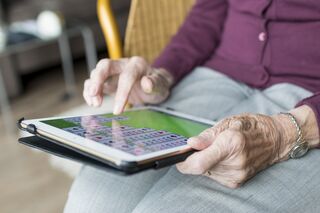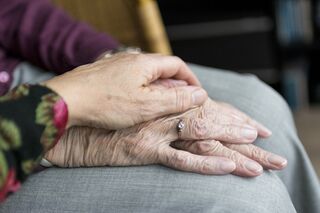Loneliness
Post–Pandemic Mindset I: Loneliness and Digital Distractions
It is perfectly possible to feel lonely in a crowd when your needs are not met.
Posted June 17, 2021 Reviewed by Kaja Perina
Key points
- Loneliness has affected the broadest range of people caught in pandemic lockdown, cut off from colleagues, family, and friends.
- It is perfectly possible to feel lonely in a crowd when your needs are not being met. Screen-based tech often makes it more acute.
- We are starved for physical contact: To be able to touch. To hug. To shake hands at the very least.

More than a year spent in isolation with screens as our primary conduit to friends, family, and the world revealed the cost of digital distractions in terms of atrophied social skills, absent human interactions, and lost connections with nature. Relying on digital intermediaries for so long a time showed just how hungry we are for physical connection. For being able to touch. To hug. To shake hands at least.
Prior experience with other coronaviruses led physicians to expect a rise in neurological and psychiatric illness following the pandemic’s surge in infections. The largest study to date, published in the well–regarded Lancet Psychiatry, concluded that one in three coronavirus survivors received a substantial neurologic or psychiatric diagnosis within six months of becoming infected. This rendered such individuals more susceptible than others to the downsides of screen distractions.
The observational study of more than 230,000 health records culled from a database of over 81 million, examined fourteen neurological and mental health diagnoses. After accounting for age, sex, ethnicity, and preëxisting conditions, it found a 44% greater incidence in these patients than in those who had endured influenza or other respiratory infections [1].
Four screen–related problems particularly exacerbated by pandemic lockdowns have been loneliness, anxiety, reactionary outrage, and a mindset of exhausted numbness. After commutes became abolished, the hours once devoted to shuttling here and there became free time, as did hours once spent frequenting restaurants, cinemas, bars, and gyms. Minutes formerly expended on errands and grocery shopping added up as well.
These dividend hours provided a natural opportunity to stop, sit still, and reflect, to rediscover intimacy and the pleasures of deep conversation within a small circle of actual friends compared to the banal chatter with a shallow hoard online. Upsides like these are good for the soul. But many did not stop to pause.
For more than a year we spent a hefty portion of our free time binging on the news and Netflix, while Verizon reported a 75% uptick in time spent gaming. We zoomed (an activity so ubiquitous it became a verb) until we could no longer think or see straight. In December 2019 fewer than 10 million people were using the platform; a short four months later saw a thirty–fold increase to 300 million. We let ourselves be swept up by mob mentality and the misinformation stream promoted by social media.
In my view the pandemic not only accelerated the ill effects of digital distractions but gave us a presentiment of future trends unless we change our habits now.

Loneliness and anxiety have affected the broadest range of those caught in pandemic lockdown. Social media and video calling apps promised to keep us connected while cooped up, away from the workplace, cut off from colleagues, and separated from family and friends. But technology made loneliness more acute by inflaming emotions and bringing out the worst in us. Young mothers particularly had a hard time. Suddenly, they had to pull off the unfamiliar demands of working from home while managing a household that might include a home–officed spouse taking up space and wanting attention, as well as children in need of full–time supervision and the stress of monitoring their screen–based schooling.
It is perfectly possible when needs are not being met to feel lonely in a crowd. Needs were not met for young moms forced to turn to Facebook and Instagram for the support they used to freely receive at the playground. According to columnist Julie Jargon, who writes about tech’s influence on family life, discussions about best–parenting practices started to heat up as soon as they moved online. “Haughty, judgmental chatter” left users feeling shamed and dismissed at a time when so many were already weary and on edge from prolonged isolation. “Even asking a question in those groups opens the door to feeling inadequate,” confided one parent.
Pandemic loneliness hit young adults hard, too. A 2021 Harvard study examined “how the pandemic has deepened an epidemic of loneliness” when people who experience social disruption had nothing but technology to fall back on. I have written here how social media is a highly edited theater of self–display that can be hell for the already lonely. Its deceptive posing invites false comparisons to the ostensible happiness of others. It also intensifies feelings of rejection, envy, and FOMO anxiety.

The downside costs of pandemic tech saturation may have changed the perspective of technology boosters who previously championed the spread of digital devices as an unalloyed good. In addition to academic skills, students would normally be learning social ones to serve them a lifetime. In acknowledging the profound need for youngsters to socialize with peers and teachers who role–model good behavior in person, libraries across the country set up drawing and calligraphy classes.
Click here for additional columns that address pandemic anxiety, reactionary outrage, and burnout. Kindly direct questions to Dr. Cytowic via the author portal.
[1] The illnesses were intracranial hemorrhage; ischemic stroke; parkinsonism; Guillain-Barré syndrome; nerve, nerve root, and plexus disorders; myoneural junction and muscle disease; encephalitis; dementia; psychotic, mood, and anxiety disorders; substance abuse; and insomnia.
References
Cytowic RE. Five Types of Loneliness During the Pandemic
Cytowic RE. Why Loneliness Hurts So Much
Cytowic RE. Does Loneliness Eat at You? Screen Media May Be to Blame.
Taquet, M., et al., 6-month neurological and psychiatric outcomes in 236,379 survivors of COVID-19: a retrospective cohort study using electronic health records. The Lancet Psychiatry, April 6, 2021. doi: 10.1016/S2215-0366(21)00084-5.
Jargon, J., New Mothers Are Lonely During Coronavirus. Mom-Shaming on Social Media Is Making It Worse. Wall Street Journal, February 20, 2021. doi: wsj.com/articles/new-mothers-are-lonely-during-coronavirus-mom-shaming-on-social-media-is-making-it-worse-11613829600.
Weissbound, R., et al., Loneliness in America: How the Pandemic Has Deepened an Epidemic of Loneliness and What We Can Do About It. Harvard Graduate School of Education, February, 2021. doi: mcc.gse.harvard.edu/reports/loneliness-in-america.




